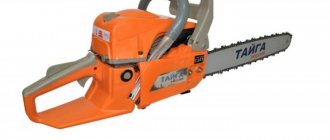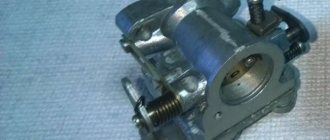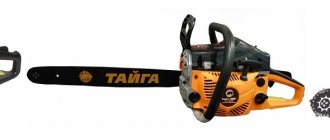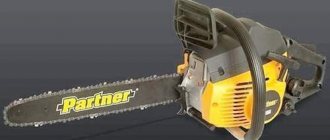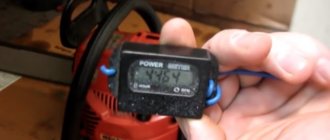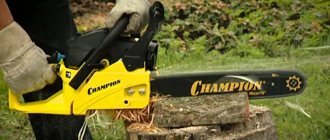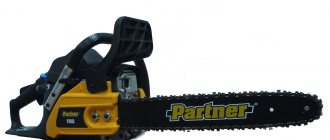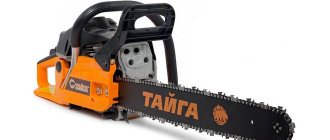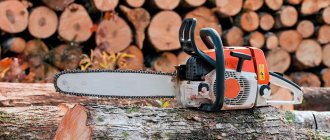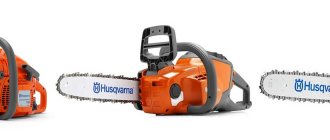Chainsaw Taiga 245: reliable saw produced by ZID
A small range of domestically produced chainsaw equipment includes several popular, simple in design and inexpensive to maintain household class models.
The Taiga 245 chainsaw has not found wide application in the field of industrial logging, but has received a positive assessment in the private sector. Part of the production capacity of the Degtyarev plant, abbreviated as ZID, specializes in the production of this model. A special feature of this development is the use of domestically produced basic components and assemblies.
Photo: chainsaw Taiga 245
Description of the Taiga 245 chainsaw
Taiga is a Russian brand, widely known to domestic users for products produced in Soviet times at the ZID plant (Dzerzhinsky plant). However, there is no information that any of the Taiga chainsaws are currently being produced at this enterprise. On the contrary, it is widely known that the company has moved its production facilities to China, where chain saws are assembled. Their quality is significantly inferior to global brands, but this disadvantage is compensated by low prices. Another disadvantage is the lack of authorized warranty and post-warranty service centers.
It should be noted that on the used equipment market you can still buy the original Russian-made Taiga ZiD saw. It is distinguished by high-quality metal parts, good assembly and a high price - from 12,500 rubles.
As for the modern model of the Taiga 245 chainsaw, it is assembled from Chinese and Russian components, but the fuel system is equipped with parts from the Japanese company Walbro. As we have already mentioned, the company pursues a balanced pricing policy, which attracts many potential owners of its equipment. Today, in Russian stores, a Chinese-made Taiga 245 chain saw can be purchased at a price of 5,000 rubles.
Basic equipment
- Manual, passport and warranty card;
- Cardboard box for storage and transportation;
- Product body with a two-stroke gasoline engine;
- Set of universal mounting tools;
- Saw guide (40 cm/16″);
- Protective case;
- Chain – pitch 3/8″;
- Transparent measuring container for preparing fuel.
Specifications
| Model | Taiga 245 |
| Manufacturer | Taiga |
| Production (assembly) | ZID |
| Homeland of the brand | Russia |
| Saw class | Semi-professional |
| Power, hp (kW) | 3,5 (2,6) |
| Engine volume, cm3 | 75 |
| Chain pitch, inches | 0,325 |
| Chain thickness, mm | 1,5 |
| Fuel tank volume, l | 0,55 |
| Oil tank volume, l | 0,26 |
| Tire length, cm (inches) | 40 (16) |
| Number of links | 76 |
| Warranty, years | 1 |
| Weight, kg | 8,95 |
Each owner receives detailed details, description and operating instructions for the Taiga 245 chainsaw when purchasing a new unit. We invite you to get acquainted with the technical characteristics of the tool, as well as download instructions for use.
Chainsaw Taiga 214
Due to the wide range of work performed, performance and maintainability, this model is still widespread among users. The device is quite massive and reliable, the saw mechanism is able to cope with any types of wood, wet wood. The engine is single-cylinder, air-cooled. Lubricant is supplied to the sawing device automatically.
Compared to more modern models, this saw is too bulky and heavy, and breakdowns can occur in various tool systems. But these shortcomings are justified by its power and high degree of unification of parts.
Specifications:
- power – 3.5 l. With.;
- chain pitch – 9.3 mm;
- fuel tank volume – 800 ml;
- oil tank – 300 ml;
- fuel consumption – 40 g*kW/hour;
- tire length – 38 cm;
- noise level – 106 dB;
- weight – 8.8 kg;
- dimensions – 857*280*272.
Technical characteristics and description of the chainsaw design
Engine and fuel system
The Taiga 214 chainsaw is equipped with a two-stroke internal combustion engine with a volume of 75 cm 3, the cylinder of which is located perpendicular to the chainsaw tire. The maximum crankshaft rotation speed is 7 thousand rpm, which is a rather modest figure compared to imported analogues. The power of the tool at maximum speed is 2.6 kW or 3.5 liters. With. this allows the use of a tire with a working length of 38 cm.
To operate, Taiga 214 uses a mixture of gasoline and oil for two-stroke engines. Fuel consumption is 600 g/kW, h. The proportion of the fuel mixture is twenty parts gasoline to one part oil.
The fuel system consists of a carburetor, fuel line and filter. The fuel filter is installed in the tank. The carburetor in the Taiga chainsaw is a single-chamber, diaphragm carburetor with a built-in fuel pump.
The fuel pump diaphragm is driven by an air pulse from the crankcase. The carburetor has three adjusting screws, one of which is responsible for adjusting the idle speed, the other two for working at low and maximum speeds.
The carburetor also has an air damper with a control lever connected to it, with the help of which the operator can regulate the air supply when starting a cold engine.
Bar and chain
As standard, the Taiga 214 chainsaw tire is equipped with a driven sprocket mounted on a shock-absorbing tab and connected to the main tire by means of a connection in a groove supported by metal springs, which makes its operation quite soft and slightly increases its service life.
Read also: Electrode consumption rate for 1 pipe joint
It is also permissible to install a solid tire as on imported analogues. The chain has a pitch of 9.3 mm.
The tire is installed on the opposite side of the starter directly onto the crankcase and is pressed by the saw chain brake cover-housing using two nuts. The chain tension adjustment screw is located where the bar is installed.
Ignition system
The Taiga 214 chainsaw is equipped with non-contact magnetic ignition with an advance angle of 30 degrees at the maximum speed of the chainsaw. It consists of a flywheel mounted on the engine crankshaft and a housing mounted on the crankcase. The ignition housing contains a transformer, a generator coil and a diode bridge, which are responsible for the quality of spark formation.
A spark plug of the AM 17 V model is installed on the Taiga 214; the optimal gap on its contacts is 0.6–0.7 mm. A protective cap is installed at the end of the high-voltage wire, and the wire itself is protected by shielding material.
Lubrication system
Chain lubricant is supplied from the oil tank through lines using a plunger pump installed at the base of the drive sprocket. The feed is carried out automatically and increases in proportion to the increase in the engine speed of the chainsaw. It is recommended to use oils with high adhesive characteristics as lubricants.
The oil tank capacity is 0.25–0.3 liters.
Lubrication of engine parts (piston, crankshaft bearings) occurs due to oil diluted in gasoline; it is for this reason that it is unacceptable to use pure gasoline in a two-stroke engine.
In order for the Taiga 214 chainsaw engine to jam, it only needs to run on pure gasoline at high speeds for just a few minutes.
Saw chain clutch and brake
The force from the engine to the driving sprocket of the tool is transmitted through a centrifugal clutch, which consists of a driving part and a driven part. The clutch assembly, using a left-hand thread, is installed on the crankshaft on the opposite side of the flywheel. As the number of revolutions increases, the driving part of the clutch, under the influence of centrifugal force, opens and comes into contact with the driven part, thereby setting it in motion.
The saw chain brake is organized using a metal plate, which, in the working position, tightly compresses the driven part of the clutch and keeps it from moving, regardless of the number of revolutions.
You should not give the chainsaw full throttle when the saw chain brake is set to the working position, as this can lead to damage to the crankshaft bearings, oil seals and overheating of the clutch.
Starter, cooling system, controls and suspension
The Taiga 214 chainsaw is started using a manual starter. The trigger mechanism is installed on the flywheel side and is also the fan housing, through which cooling air is supplied to the cylinder. Air is pumped using fan blades mounted on the flywheel.
Starting a chainsaw without the help of a starter, as well as its operation in the absence of this element, are not provided for by the manufacturer.
The gas trigger is located on the rear handle, which is integral with the front handle and is attached to the Taiga 214 Chainsaw engine using three steel shock-absorbing springs. Springs reduce the level of vibration transmitted from the tool’s engine to its handles, thereby ensuring comfortable work with the saw.
Carburetor
The carburetor of the Taiga 245 chainsaw deserves special attention, because... Most of the malfunctions are caused by it. Taiga 245 is equipped with a floatless membrane-type carburetor KMP-100US, with a built-in pump. The pump supplies fuel from the tank to the carburetor.
Main structural elements of a carburetor:
- pressure regulator;
- air damper;
- throttle valve;
- mixture adjustment screws;
- fuel pump.
Some Taiga 245 chainsaws were equipped with Japanese Walbro carburetors. There is no data on them.
There is no need to adjust the carburetor for no reason, because... It comes from the factory with optimal adjustments. Additional adjustment of the carburetor may be required if there is a sudden change in temperature, or after disassembling the carburetor itself. It should be carried out strictly according to the instructions using 3 screws responsible for adjusting the supply of the fuel-air mixture.
Determining the cause of the non-working condition of the Taiga-245 chainsaw.
Two days of fiddling with the chainsaw was enough to diagnose it, and the time for repair came in the evening of the second day. We have identified two reasons for the inoperability of the Taiga-245 chainsaw .
- 1. The segment key of the magneto flywheel is broken.
We were a little upset. We made a new one. The source of the material was an old support wheel pin from a ZAZIK.
- The workpiece was cut to the required size.
- Without effort, constantly cooling in water, they ground it on an emery stone.
- Adjusted to the required size.
- We polished it with a sharpening stone and installed the resulting key in its place.
How was the broken segment key determined? When trying to start the engine, we noticed a kickback, indicating early ignition timing. We also noticed rare flashes in the muffler or carburetor.
- 2. The volume of fuel in the working chamber of the carburetor does not correspond to the amount of fuel consumed by the engine in all modes.
The source of the cause was the spring of the rocker arm, which opens the fuel valve at the moment of discharge and the deformation of the lever of the rocker arm itself.
In our opinion, the constant compression of the spring during operation of the chainsaw led to its slight deformation, but sufficient to change the operation of the carburetor and thereby disrupt the operation of the chainsaw engine.
The rocker arm also turned out to be slightly bent and, when fully pressed by the diaphragm pusher, it could not fully open the fuel valve. The engine did not have enough fuel under load. But because of the soft spring, when trying to start the engine, there was so much fuel that the spark plug was flooded and, naturally, starting the engine was the most stressful and time-consuming process.
- We selected a new spring of the appropriate diameter and with a little more rigidity.
- We bent the rocker arm 1mm-1.5mm towards the pusher.
How was the change in the amount of fuel in the carburetor determined?
- Lack of stable engine idling.
- When tilting the chainsaw during a stall or when moving the chainsaw from the starting point to the workplace, the engine changed speed and stalled in a few seconds, after which the chainsaw could be started again with great difficulty only after blowing out the cylinder or after the chainsaw had stood for 20- 25 minutes. By the way, the fuel tank breather was not clogged and the check valve in it worked perfectly.
- After sharply pressing the accelerator handle, the chainsaw engine did not suddenly reach maximum speed.
- After lowering the accelerator, the engine did not go into idle mode, but smoothly slowed down its speed, after which it stalled, even when the accelerator (throttle) was pressed back sharply.
After our minor repairs, we carefully assembled all the disassembled parts of the chainsaw and began its test run. For this case, we use only low-octane gasoline A-76 (or normal-80).
As a rule, after opening the carburetor, there will be no gasoline in its chambers, especially since the Taiga-245 chainsaw does not have a manual fuel pre-pump - a primer. But we are not used to giving in.
- Using a conventional medical syringe, a little air was pumped through the breather of the fuel tank into the tank itself, thereby increasing the pressure in it and fuel filled the chamber of the carburetor fuel pump through the gas line.
- We closed the air damper, turned the ignition switch to the 'on' position and cranked the starter several times until the first flash. What a joy we were when the engine started the first time! It's incredible, but true that minor wear or minor deformation of a part can greatly affect the performance of the entire engine.
Then, after warming up the engine, we adjusted the carburetor for idle speed and for operating mode at maximum loads.
Adjusting and tuning the KMP-100US carburetor on the Taiga-245 chainsaw.
After we replaced the fuel valve rocker arm spring, according to the recommendations of the manufacturer, the mode nozzle screws were set to their original position: idle speed - unscrewed 2-3 turns from the end point (stop), the operation nozzle screw (working) was unscrewed 5°-10° from the stop. The screw for fixing the final position of the throttle was screwed in so that the throttle valve remained slightly open, creating a gap of 2mm-3mm.
To adjust the carburetor, you must try very hard to start the chainsaw engine, and when this happens, do not let the engine stall.
In the first minutes of operation after a test run, you can rotate the idle jet screw in order to somehow maintain the operation of the warming up engine. Do not try to check the maximum speed of the chainsaw when it is cold. This has a bad effect on the condition of the engine.
When the engine is warm enough, you can confidently begin adjusting the carburetor.
- By smoothly rotating the idle jet screw, we check what position it is in: too turned out or screwed in from the maximum engine speed position.
When the screw is fully screwed in, the fuel channel of the nozzle is completely blocked and a fuel-air mixture cannot form. Starting the engine in this condition is very difficult, and sometimes impossible. When you unscrew the screw (counterclockwise rotation), the amount of fuel passing through the nozzle gradually increases. The moment of ideal saturation of the fuel-air mixture comes, as evidenced by the maximum engine speed at idle.
In other words, we can say that when the idle jet screw is unscrewed, the fuel-air mixture gradually becomes richer and a moment comes when the engine speed reaches a certain maximum value for idle mode, and then begins to drop noticeably. This indicates that the mixture is now becoming rich.
- We turn off the idle speed screw until the engine has passed the moment of maximum speed and noticeably reduces its speed.
- By rotating the limit screw counterclockwise or clockwise, we adjust the position of the throttle valve.
Since we set the idle speed screw to a rich (enriched) mixture mode, when we screw in the throttle valve screw, our fuel-air mixture will gradually become leaner. The flap will open slightly. The air flow will increase. The engine will begin to gain speed.
- The damper must be installed in a position where the engine speed will not increase further. Opening the throttle gradually will cause rough operation and the engine may stall. The mixture becomes lean. Closing the valve enriches the mixture.
- Turn the screw out a little, 2°-5°, and leave it in that position.
- By smoothly rotating the idle speed adjustment screw, we select a position in which the engine maintains stable idle speed and the saw chain on the bar does not rotate.
The optimal idle mode will be established provided that the engine receives a sufficient amount of an ideal fuel-air mixture corresponding to its working volume and compression ratio.
Adjusting the KMP-100US carburetor on the Taiga-245 chainsaw at maximum load.
Adjusting the KMP-100US chainsaw carburetor in engine operating mode is a little simpler and is checked first at the place where the chainsaw engine is started, then in maximum load mode.
When we have established a stable idle speed for the chainsaw engine, by gently pressing the accelerator handle we check the ability of the carburetor to provide the engine with a fuel-air mixture at maximum speed.
- If the speed is insufficient, then by turning the working jet screw 1/10-1/8 counterclockwise from the stop, we achieve the maximum possible engine speed with a smooth sound, reminiscent of the sound of a four-stroke engine.
- When you sharply press the accelerator handle, the engine should also quickly gain speed. When released sharply, quickly switch to stable idle mode.
If this does not happen and a short-term failure is observed, then the working jet screw needs to be unscrewed a little more. When, when you sharply press the accelerator lever, the maximum engine speed is not observed and interruptions in operation are noticeable, the adjusting screw of the working jet needs to be screwed in a little.
Turning this screw in reduces the amount of fuel in the engine operating mode and the mixture becomes leaner. Turning it out enriches the air-fuel mixture.
And the final stage of tuning consists of checking and adjusting the operation of the engine at its maximum load.
And so, our saw holds idle speed steadily and has a good response to control of the accelerator lever. But how will it perform at work under maximum loads?
They brought a dry beech tree to a log and tried to saw it. The engine slowed down a bit and a faint smoke appeared in the exhaust. Rich mixture. We tightened the working jet screw a little and lowered the chainsaw with a chain onto a beech log, added gas, and our “Taiga-245” easily coped with the job with a joyful growl.
The next cut was made with moderate chain pressure on the log and at maximum engine speed. 'Taiga' sang smoothly, like new. We cut about one stack of wood. The chainsaw never stalled during operation or in transient modes, the maximum speed under load was maintained, and the idle mode did not go astray. We were pleased.
As for gasoline.
The chainsaw engine is designed for the 76th or 92nd, pour in the appropriate one. High-octane gasoline requires a higher compression ratio to ignite than low-octane gasoline. For high-octane gasoline to ignite in an engine with a low compression ratio, the engine must be at least sufficiently warm and the mixture must be slightly rich.
But again: we enrich the mixture - we do not allow the gasoline to burn completely. The result is increased fuel consumption, soot in the exhaust, spark plug overflow, unstable operation under load and in transient conditions, and difficult engine starting. We lean the mixture - additional heating of the engine and other troubles.
These are just our observations and are not mandatory recommendations for you. The choice is yours.
- How to Start a Stihl 180 Chainsaw
- How to Cut a Countertop at Home
- How to Clean the Carburetor of a Stihl 180 Chainsaw
- Which Circular Saw is Best for the Home
- Adjusting the Carburetor of a Stihl 250 Chainsaw with Your Own Hands
Chainsaw Taiga 245
Taiga 245 is a chainsaw from a Russian manufacturer, produced at the Degtyarev plant, abbreviated as ZID. The high power of the motor allows it to be used both for work in the forest and for domestic needs. Today, the Taiga chainsaw is obsolete, but continues to enjoy popularity among the country's population. The saw rarely breaks, so let’s look at the main possible breakdowns and how to remove them with your own hands.
IMPORTANT. An experienced electrician leaked to the network the secret of how to pay half for electricity, a legal way. Read more
Application
Despite its power, the Taiga 245 chainsaw was not widely used by woodcutters (of which there are plenty of reviews about the saw) due to its low fault tolerance. Still, when working in the forest, you need a more reliable tool: Stihl, Makita, Husqvarna. Carburetor adjustment. The Taiga 245 chainsaw is different from a modern chainsaw. The saw found its main use in everyday life. It is perfect for all household purposes:
- cut a slab;
- cut down a small tree;
- saw old boards;
- trim branches;
- buck the whips.
Device
Taiga 245 is a modern chainsaw, made in a plastic case made of impact-resistant material. A photo of this chainsaw can be seen below Taiga 245 chainsaw from the carburetor and. Is not afraid of falls or impacts of medium strength, because... Most of the parts are made of metal. It should be noted that it weighs 8.95 kg, not including fuel. Such saws weigh significantly less.
Saw dimensions: 900 x 280 x 300. Supplied complete with a saw set based on a 40 cm bar and a chain with a pitch of 9.3 mm.
The Taiga chainsaw is based on a 2-stroke internal combustion engine with a power of 2.6 kW, which is achieved when the crankshaft rotates at 7000 rpm. The working volume is 75 cubic cm. The piston group cylinder is not hardened, this reduces the service life of the chain saw. Taiga 245 is a chainsaw with additional carburetor adjustments. This aspect is important for huge volumes of work, where the saw operates under load for a long time, virtually without stopping. In domestic use, it is not critical whether the piston is hardened or not. The piston size is 50 mm in diameter. The manufacturer advises using the chainsaw for less than 40 minutes; after this time, the tool should rest.
The chainsaw is not hazardous to the environment provided it is used with specially designed oils.
Taiga 245 uses universal motor oil for both the chain and the motor. It is diluted in a ratio of 1 to 20. Yes, yes, specifically 1/20 - this is a distinctive feature of the Taiga 245 saw. The brand of gasoline is AI-92. As noted above, the same oil is used to lubricate the chain as is used in the engine. In summer, the oil should be diluted with gasoline in a ratio of 1/4. According to reviews from many saw owners, used oil (waste oil), for example from a car engine, can be used to lubricate the chain.
Carburetor
The carburetor of the Taiga 245 chainsaw deserves special attention, because... most of the defects occur specifically in it. The carburetor of the Taiga 245 chainsaw may require additional carburetor adjustment. Taiga 245 is equipped with a floatless membrane-type carburetor KMP-100US, with an integrated pump. The pump supplies fuel from the tank to the carburetor.
The main structural elements of the carburetor:
- pressure regulator;
- air damper;
- throttle valve;
- consistency adjustment screws;
- fuel pump.
Repair and adjustment of the KMP-100 carburetor from the Ural chainsaw
Many people have asked to make a video on carburetor
, and now I have this opportunity.
Adjusting the chainsaw carburetor.
Adjusting the chainsaw carburetor
.
Some Taiga 245 chainsaws were equipped with Japanese Walbro carburetors. There is no data on them.
There is no need to adjust the carburetor for no reason, because... It comes from the factory with optimal adjustments. Additional adjustment of the carburetor may be required if there is a sudden change in temperature, or after disassembling the carburetor itself. Order chainsaw goodluck gl4500m original at the best price if the carburetor adjustment is not correct. It should be carried out strictly according to the instructions using 3 screws responsible for adjusting the supply of the fuel-air mixture.
Specifications
Semi-professional model. Adjusting the carburetor of the Taiga chainsaw, if the Taiga chainsaw starts up normally. It is distinguished by its heavy weight, powerful engine, and increased fuel consumption.
Main technical characteristics of the Taiga 245 chainsaw:
- Weight without fuel and lubricant: 8.95 kg.
- Engine: 2-stroke, 2.6 kW (3.5 hp).
- Chain pitch: 9.3 mm.
- Fuel tank capacity: 700 – 800 ml.
- Chain lubrication tank capacity: 260 ml.
- Start: manual.
- Fuel consumption - 600 g/kW h.
- Tire: 40 cm;
- Productivity: from 70 sq.m. see per second.
- Noise level: 105 dB.
DIY repair
The Taiga 245 chainsaw does not last forever and tends to break, like any other equipment. The design of the saw is simple and allows you to repair it with your own hands, almost on your knees, using a handy tool. Let's look at the main breakdowns.
Taiga 245 manual is the main chainsaw document that you should rely on during repairs. Setting up and adjusting the carburetor of a chainsaw 0.1 chainsaw taiga 245 repair. We strongly recommend that you study not only the description, but also the content.
Engine
Dvitagel is one of the weak points of the Taiga 245 chainsaw. Common problems:
- the engine does not start;
- the engine starts, but runs unstable and/or stalls;
- works unsteadily;
- does not develop full power.
Most of the listed malfunctions occur in the saw due to problems in the ignition system. As everyone knows, the main element of the ignition system is the spark plug, therefore, the first step is to carry out a visual inspection of it.
If you can see excess fuel mixture on the spark plugs, it means it has been “flooded”; you should wipe the spark plug, dry it, put it back and try to start again.
Assess the color of the carbon deposits on the spark plugs. If it is sand-colored, then the spark plug is working. Chainsaw taiga. 245 when it is necessary to adjust the carburetor when operating a chainsaw. For any other color: black, yellow, red, gray, it should be replaced.
If the chainsaw spark plug is dry, then there is a problem with the fuel supply to the combustion chamber; you should check the fuel supply system.
Fuel supply system
If a malfunction is detected in the fuel supply system (dry spark plug), the first thing you should check is:
- Check the fuel filter.
- Check the flow of fuel into the combustion chamber.
Dirty filter - replace. The recommended replacement interval is once every 3 months.
To check whether fuel is flowing or not, you need to remove the hose from the carburetor and see if the fuel flows or not. If fuel comes out of the hose, then the problem lies in the carburetor. If fuel does not flow, clean the hose.
Cylinder - piston group
Problems with the CPG are classified as serious and entail high repair costs. The main causes of CPG problems are a drop in power. You can identify problems with the piston by measuring the pressure with a compression gauge in the combustion chamber. To do this, remove the spark plug, insert the device in its place and try to start the saw and look at the device readings. If the instrument needle is in the red zone (8-9 atmospheres), then piston repair is 100% necessary.
Chain brake
The chainsaw chain is stopped by a special brake band; when it becomes clogged with dirt from sawdust and oil, problems with the brake appear. The housing should be removed and thoroughly cleaned of dirt.
Muffler
Over time, the muffler becomes clogged with combustion products from the spark arrester, which causes difficulty in removing exhaust gases. By creating excessive resistance in the exhaust tract, the chainsaw stops developing maximum speed. Also, the muffler becomes clogged due to excess oil in the fuel mixture.
To repair it yourself, you will need to dismantle the muffler, disassemble it and clean it thoroughly. You may have to resort to using detergents.
After dismantling the muffler, be sure to plug the exhaust hole with a rag to prevent foreign objects from getting inside the chainsaw.
Before installation, do not forget to dry the muffler with a hairdryer.
Video
We invite you to watch a video demonstrating the operation of the ZID Taiga 245 chainsaw. A Soviet-era saw is used to cut a tree with a diameter of a meter. We recommend viewing.
Conclusion
Chainsaw Taiga 245 is perfect for home use. It still lacks reliability for working in the forest and is hampered by excess weight. Husqvarna chainsaw carburetor adjustment on carburetor. Video. Chainsaw Taiga pro TBP-4000 in chainsaw Taiga 245. Adjusting the carburetor of the chainsaw. The chainsaw is easy to repair; most faults can be fixed with your own hands. Spare parts are available and not expensive. The affordable price covers all the shortcomings and makes it an excellent mid-range saw in its class.
Identifying and eliminating obvious chainsaw faults.
To determine the reason why the chainsaw does not start or stalls when starting, it is necessary to troubleshoot the tool. The essence of the procedure is a sequential inspection of the condition and operation of the main working elements of the saw engine. At this stage we check:
- Presence of a spark on the spark plug;
- Fuel supply;
- Filter status;
- Operation of the breather built into the fuel cap of the stalling unit;
- Functioning of the exhaust channel.
Checking the spark on the spark plug and eliminating the causes.
The first step in finding the reasons why a gasoline saw does not start is to check the spark on the spark plug. There are many factors that influence the operation of this element. However, the main ones at the initial stage of tool troubleshooting are:
- Incorrect carburetor adjustment;
- The presence of more than the required amount of oil in gasoline;
- Air filter clogged.
All of them contribute to the formation of carbon deposits on the spark plug electrodes. In 50 cases out of 100, saws do not start when cold due to the lack of a spark due to carbon deposits on the electrodes and their corrosion. The result is either a decrease in the gap or an increase in it.
Checking the spark plug of a non-working chainsaw
Checking for spark is quite simple. To do this you will need:
- Remove the tip of the high-voltage wire;
- Unscrew the spark plug;
- Put the tip back on;
- Place the candle skirt against the cylinder;
- Start with the starter.
If at the moment the chainsaw engine starts, a good spark is observed between the electrodes, then everything is in order with the ignition unit. If it is not there, then it is worth cleaning the element itself and checking the electrode gap. If necessary, use a special probe to adjust the distance between the contacts.
For spark plugs from different manufacturers, the distance between the electrodes may vary. For some it may be equal to 0.5 mm. Others have 0.2 mm. Therefore, carefully study the manufacturer's recommendations.
There may be no spark at the spark plug for other reasons. The main malfunctions that affect poor starting of the chainsaw and unstable operation of the internal combustion engine at idle, which can cause the tool to stall, include the following:
- Overfilling of the spark plug channel with fuel;
- Lack of contact between the high-voltage cradle and the tip of the spark plug;
- Failure of the ignition unit.
How to start a cold chainsaw if the spark plug channel is constantly flooded with gasoline? You can fix the problem while starting the tool using the following algorithm:
- Unscrew the spark plug with a special wrench;
- Wipe it with a clean and dry cloth;
- Dry for 20...30 minutes;
- Remove carbon deposits with a file and adjust the gap between the electrodes;
- Drain the remaining fuel from the spark plug channel and dry it;
- Collect everything and try to start the mechanism.
As a rule, these measures are quite enough to start the chainsaw and get the job done. However, this extreme measure does not eliminate the main reason why the engine does not start or stalls - improper operation of the carburetor, which needs fine adjustment.
If there is no spark due to poor contact of the high-voltage cradle with the tip of the spark plug, it is necessary to check the connection. The test can be carried out using a regular tester. If a defect is detected and corrected, the chainsaw should start without any problems.
Read also: DIY granulator from a meat grinder video
If the check shows that the contact is reliable, but the saw still does not start, look for the reason in the ignition unit. As a rule, a faulty unit cannot be repaired or restored. This will require a complete replacement.
We determine the availability of fuel and its supply.
First, you need to make sure that there is a fuel mixture in the tank of the chainsaw that does not want to start, and that it is properly supplied to the carburetor. With a full tank, check how the mixture is supplied through the gas line. We disconnect the fuel system pipe from the carburetor and try to pump it up. In case of complete order, when pumping, gasoline will be supplied jerkily in accordance with the standards set by the manufacturer. Weak fuel supply or its absence can result from:
- The fuel supply channel is clogged;
- Fuel filter clogged with debris.
Often the cause of poor starting of a chainsaw can be a too full tank. In this case, you should pay attention to the presence of smudges under the saw housing cover. If they are present, then look at the connection of the gasoline supply pipe to the carburetor. Most often, it is squeezed out by pressure when screwing on the tank cap, which is tucked right under the neck, which prevents the engine from starting.
The quality of the fuel mixture can also be one of the reasons why the chainsaw does not start. If, after completing the work, you do not drain the remaining gasoline and leave the tool for long-term storage (more than 2 weeks), then the processes of resin formation and polymerization of the components will begin to occur inside the tank. What can cause carbon deposits to appear on the piston, rings and cylinder liner. Therefore, always prepare the mixture in only the required quantity before work.
Checking the condition of the fuel and air filters.
If the fuel quality is fine, the chainsaw engine may not start due to clogged fuel and air filters. To diagnose these elements, you will need to perform a number of manipulations associated with their dismantling.
For fuel filter:
- Disconnect the gasoline supply line from the carburetor;
- Pump up the fuel.
If there is little or no pressure in the pipe, disconnect the filter. Before doing this, empty the tank of the mixture and remove the filter element itself. Dismantling is done using a wire hook. A clogged replacement cartridge that causes poor starting of the chainsaw engine can be cleaned, but it is best to replace it with a new one. When using the tool in dusty conditions, cleaning should be done on a regular basis.
A clogged air filter can cause the chainsaw engine to run rough, causing it to stall or be difficult to start. Dust and dirt deposited on the adsorbent material make it difficult for air to enter the system, making the fuel mixture so rich that it will sometimes be difficult to start the tool.
Checking the air filter is one of the first steps in finding the causes of poor starting.
Removing the air filter should be done with caution, since dust accumulated on its surface during operation of the saw can get into the carburetor. And this is fraught with more expensive repairs. After disconnecting the cartridge, thoroughly clean it of accumulated dirt and wash it with detergent. Dry the element and carefully put it back in place.
Checking the breather and cleaning it.
The breather is another element, due to improper operation of which the chainsaw may not start or stall during the sawing process. This element is located on the fuel tank cap in the area of the air hole. This is a kind of valve that does not allow gasoline to leak out and equalizes the air pressure necessary for the free flow of fuel into the carburetor.
If the breather is dirty, the running chainsaw stalls, and when started, it refuses to start. The whole point is that air stops flowing through the hole. As a result, negative pressure (vacuum) is created inside the fuel tank, preventing the flow of gasoline to the carburetor.
Read also: Is it possible for nursing mothers to bake pumpkin?
Identifying the problem is quite simple. Disconnect the fuel supply hose from the carburetor and see what happens to the gasoline. If it flows freely in a good stream, then everything is in order with the breather. If it is absent or it flows weakly and intermittently, then the cause is identified - the breather is clogged with dirt. The problem can be solved by cleaning the air hole with a regular needle or a powerful jet of compressed air.
Checking the exhaust channel of the chainsaw.
One of the reasons that a chainsaw is difficult to start may be a clogged exhaust channel or its muffler. At the same time, there is a drop in power during sawing of lumber and logs. Most often this occurs due to tarry deposits on the spark arrester or muffler channel, which are formed during the combustion of a low-quality mixture of gasoline and oil, preventing the exhaust gases from being vented.
A resonator clogged with carbon deposits can cause a gasoline saw to start poorly.
The cause of poor starting of the chainsaw, in this case, can be eliminated by removing the accumulated combustion products. To do this, perform a number of manipulations:
- Remove the muffler by unscrewing the screws;
- Remove the cooling panel and sealing gasket;
- Remove the spark arrester;
- Disassemble the resonator body;
- Wash all elements from carbon deposits using detergent;
- Let them dry completely;
- Reassemble everything in reverse order;
To prevent dust and sand from entering the cylinder when cleaning the muffler, cover the exhaust duct of the chainsaw engine with a clean rag.
Preparing for operation of the Taiga chainsaw
- When purchasing a tool, we advise you to carefully check it for any visible damage or malfunctions. If any are found, ask the seller to replace the chain saw or eliminate the defects.
- Check the completeness of the chainsaw and ask the seller to test run the engine to make sure it is working;
- Before unpacking and assembling the Taiga chainsaw, carefully read the manual, study the device, technical and operational characteristics, read the maintenance recommendations and safety regulations;
- Mount the saw set of the Taiga chainsaw and install the chain so that the cutting edges of the links are directed in the direction of rotation of the driven star. Adjust chain tension.
Important: with proper tension, none of the chain links sags under its own weight, and the chain itself rotates easily on the bar, under slight hand pressure. It should be remembered that during operation the metal heats up, which leads to stretching of the links. We recommend turning off the engine after 10-15 minutes of operation, checking the chain tension and, if necessary, adjusting it;
- After installing the saw set, check the reliability of fastening of other components and parts. If any defects are found, tighten the mounting screws and nuts;
- Prepare fuel, refuel the saw and pour oil into the tank of the automatic lubrication system;
- Inspect the body of the instrument for leaks and, if necessary, eliminate the leak;
- Engage the chain stop brake and start the engine as recommended in the manual.
The most common breakdowns of the Taiga 214 and their elimination
As with any equipment, breakdowns sometimes occur in the Taiga chainsaw; we will list the most common ones and consider how to diagnose and fix the malfunction.
Engine won't start
The most likely reason that the engine does not start is the lack of a spark between the spark plug electrodes or an interruption in the fuel supply. In this regard, the following actions must be taken:
- Check the spark and condition of the electrodes on the spark plug and, if necessary, clean or replace it.
- Check the presence of fuel in the tank.
- Inspect the chainsaw for fuel leaks through torn fuel lines, and repair if found.
- Clean the fuel filter
- If the spark plug is wet and there is a spark on it, the most likely cause of the breakdown is a poor-quality fuel mixture. To fix this, you need to adjust the carburetor.
The engine does not develop full power
- It is necessary to check what position the saw chain brake is in; if it is on, turn it off.
- If the Taiga 214 confidently holds idle speed and at the same time does not develop full power, the reason is most likely in the carburetor settings. The high speed screw needs to be adjusted.
- Check the engine crankcase for leaks, if the idle speed fluctuates and eliminate them if detected
The instrument stalls
If the chainsaw stalls, the actions described in the paragraph “Engine will not start” will help.
Adjusting the chainsaw carburetor
Carburetor adjustment involves adjusting the engine to local conditions, such as climate, altitude, gasoline quality and type of 2-stroke engine oil.
The carburetor for almost any chainsaw is equipped with three adjustment options:
“L” – low speed jet;
“H” – High speed jet;
“T” - Screw for adjusting idle speed.
The “L” and “H” jets regulate the amount of fuel so that it matches the air flow supplied by the chainsaw throttle valve. If the jets are screwed in clockwise, the mixture will be lean (less fuel relative to the amount of air), and if the jets are unscrewed counterclockwise, the mixture will be richer. A lean fuel mixture produces higher rpms, while a richer mixture produces lower rpms.
Screw “T” can be used to adjust the throttle position at idle speed. If the “T” screw is turned counterclockwise, the idle speed will increase, and if the screw is turned counterclockwise, the idle speed will decrease.
Chainsaw doesn't cut well
- In this situation, the problem is most likely a dull saw chain of the tool. It needs to be replaced with a new one or sharpened.
- Check the supply of lubricant to the saw bar; if it is missing, diagnose the lubrication system and eliminate malfunctions.
The tire pulls to the side
- It is necessary to inspect the tire and, if increased wear is detected, replace it with a new one.
- The teeth of the chain on one side are much higher than the teeth on the other side; it is necessary to sharpen the chain correctly and adjust the cutting depth.
The driven tire sprocket rotates with jamming
The problem is that debris has gotten into the sprocket bearing, you need to wash the tire in gasoline and check again; if such actions do not help, then the cause is wear of the bearings and the tire needs to be replaced.
Read also: Wood carving attachments for engravers
The chain spins at idle
The main reasons why the chain may spin at idle are incorrect idle speed adjustment on the carburetor and a broken spring in the clutch mechanism of the tool. You must first inspect the clutch for faults and eliminate them if any, and then, if necessary, adjust the idle speed on the carburetor.
Choosing the right Kedr chainsaw carburetor
The Kedr chainsaw carburetor is a typical carb designed for proper mixing of the fuel-air mixture and its supply to the engine. In the old Russian traditions, this trademark is today carried out by China. This is the format of professional high-quality production when both the country of origin and our store are responsible for the product. To get a global node cheaply, you just need to know its modification and labeling, and after that, place an order.
For anyone interested in wholesale, we are open to large-scale sales, and we recommend downloading the price list in advance. buy a carburetor for a Chinese chainsaw only in cases of using low-quality fuel or lack of proper care for the chainsaw, for example, we are talking about the type of storage during the off-season without preservation. They also buy a list of other spare parts from us cheaply - all because the price on the Benzo Zip website is always stable. Whether you live in Dnipro or in another city, we deliver to any location in the country of Ukraine. It turns out that to buy a carburetor for a chainsaw, you just need to carefully read our article materials.
